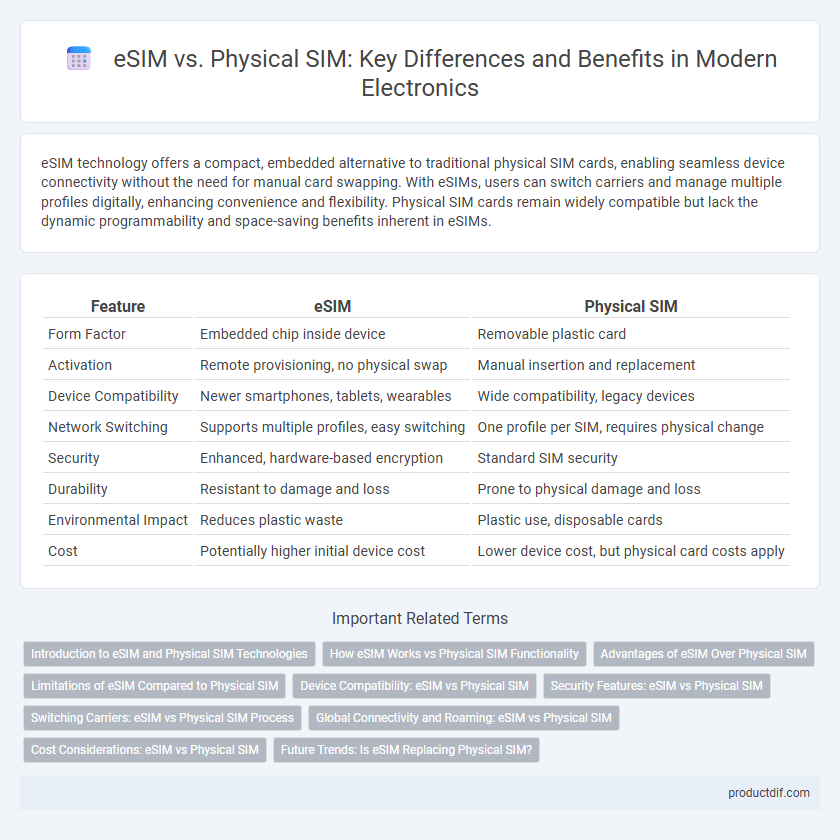eSIM technology offers a compact, embedded alternative to traditional physical SIM cards, enabling seamless device connectivity without the need for manual card swapping. With eSIMs, users can switch carriers and manage multiple profiles digitally, enhancing convenience and flexibility. Physical SIM cards remain widely compatible but lack the dynamic programmability and space-saving benefits inherent in eSIMs.
Table of Comparison
| Feature | eSIM | Physical SIM |
|---|---|---|
| Form Factor | Embedded chip inside device | Removable plastic card |
| Activation | Remote provisioning, no physical swap | Manual insertion and replacement |
| Device Compatibility | Newer smartphones, tablets, wearables | Wide compatibility, legacy devices |
| Network Switching | Supports multiple profiles, easy switching | One profile per SIM, requires physical change |
| Security | Enhanced, hardware-based encryption | Standard SIM security |
| Durability | Resistant to damage and loss | Prone to physical damage and loss |
| Environmental Impact | Reduces plastic waste | Plastic use, disposable cards |
| Cost | Potentially higher initial device cost | Lower device cost, but physical card costs apply |
Introduction to eSIM and Physical SIM Technologies
eSIM (embedded SIM) technology integrates the SIM functionality directly into the device's hardware, enabling remote provisioning and eliminating the need for a physical card. Physical SIM cards, traditionally made from plastic with an embedded microchip, must be physically inserted and swapped to change carriers or plans. eSIMs enhance device design flexibility and support multiple profiles, revolutionizing connectivity in smartphones, wearables, and IoT devices.
How eSIM Works vs Physical SIM Functionality
An eSIM is an embedded SIM chip soldered directly onto a device's motherboard, enabling remote provisioning of carrier profiles through software without the need for physical card swapping. Physical SIMs store subscriber information on a removable card that must be manually inserted or replaced to change network providers. eSIM technology offers enhanced flexibility, space-saving design, and eliminates the risk of SIM card damage compared to traditional physical SIM functionality.
Advantages of eSIM Over Physical SIM
eSIM technology offers significant advantages over physical SIM cards, including enhanced convenience through remote provisioning and activation without needing a physical swap. It enables multiple carrier profiles on a single device, improving flexibility and reducing the risk of damage or loss inherent with physical SIM cards. Furthermore, eSIMs contribute to better device design by freeing up internal space, allowing for slimmer and more water-resistant electronics.
Limitations of eSIM Compared to Physical SIM
eSIM technology offers convenience but faces limitations such as compatibility issues with older devices and restricted carrier support globally. Physical SIM cards allow easy swapping between devices without requiring network activation, unlike eSIMs which need carrier provisioning. Furthermore, data recovery and transfer are simpler with physical SIMs due to their tangible nature, whereas eSIMs rely heavily on software interfaces, posing potential security and usability challenges.
Device Compatibility: eSIM vs Physical SIM
Device compatibility varies significantly between eSIM and physical SIM technologies, with eSIMs offering broader support across the latest smartphones, tablets, and wearables, including models from Apple, Samsung, and Google. Physical SIM cards maintain compatibility with a wider range of legacy devices and budget-friendly models that lack eSIM hardware. Manufacturers increasingly integrate eSIM support to enable dual-SIM functionality and seamless carrier switching without requiring physical card changes.
Security Features: eSIM vs Physical SIM
eSIMs offer enhanced security features compared to physical SIMs by embedding cryptographic keys directly into the device, reducing the risk of SIM swapping and physical SIM theft. Physical SIM cards are vulnerable to cloning and unauthorized removal, which can lead to identity theft and data breaches. eSIM technology supports remote provisioning and activation, enabling secure updates and management without exposing the SIM card to physical tampering.
Switching Carriers: eSIM vs Physical SIM Process
Switching carriers with an eSIM involves downloading a new carrier profile directly to the device, eliminating the need for a physical card swap and reducing downtime. Physical SIM switching requires removing the existing SIM card and inserting a new one, potentially causing delays if the card is unavailable immediately. eSIM technology streamlines the carrier change process with remote provisioning, enhancing convenience and flexibility compared to traditional SIM card handling.
Global Connectivity and Roaming: eSIM vs Physical SIM
eSIM technology enhances global connectivity by allowing seamless switching between multiple network carriers without the need to physically change SIM cards, offering improved flexibility and convenience for international roaming. Physical SIM cards often require manual replacement or acquisition of local SIMs to access regional networks, which can cause delays and additional costs during travel. With eSIM, users benefit from instant activation of local profiles, reduced roaming charges, and simplified management of multiple subscriptions worldwide.
Cost Considerations: eSIM vs Physical SIM
eSIM technology reduces costs by eliminating the need for physical manufacturing, packaging, and distribution of SIM cards, offering long-term savings for mobile carriers and consumers. Physical SIM cards incur expenses related to production, logistics, and replacement, which can accumulate over time, especially for frequent travelers or users requiring multiple device activations. Cost efficiency of eSIMs also stems from streamlined device provisioning and activation processes, minimizing operational expenditures compared to traditional physical SIM management.
Future Trends: Is eSIM Replacing Physical SIM?
eSIM technology is rapidly advancing, enabling remote provisioning and multiple profiles on a single device, which enhances flexibility and user convenience compared to physical SIM cards. Industry forecasts indicate a significant shift toward eSIM adoption by major smartphone manufacturers and carriers, driven by increasing demand for seamless connectivity and IoT integrations. While physical SIMs remain prevalent in emerging markets, the trajectory clearly favors eSIMs as the future standard for mobile network access.
eSIM vs Physical SIM Infographic

 productdif.com
productdif.com